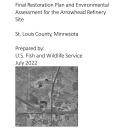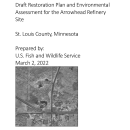Overview
The Arrowhead Refinery is a former oil recycling facility located within the St. Louis River watershed in Hermantown, St. Louis County, Minnesota. The facility was in operation from 1961-1977 and was situated on a palustrine forested, scrub-shrub wetland, surrounded by commercial, residential, and public use. Facility operations generated approximately 7,000 cubic yards of highly acidic, metal-laden sludge, which was disposed of in a 2-acre unlined lagoon on the property and wastewater ditch in a wetland area. Analyses conducted by the State of Minnesota indicated that the ground water and surface water near the site were contaminated with polychlorinated biphenyls, phenols, cyanide, lead, barium, arsenic, cadmium, chromium, and selenium. The U.S. Environmental Protection Agency (EPA) placed the Arrowhead Refinery site on the National Priorities List on August 1983. Analysis of monitoring wells and surface water by the State of Minnesota in 1983 confirmed that contaminants had migrated from the Site.
Settlement
The State of Minnesota, represented by the Minnesota Department of Natural Resources and the Minnesota Pollution Control Agency, and the Department of Interior, represented by the United States Fish and Wildlife Service, developed a claim for the natural resource damages at the Site and serve as co-trustees. The claim reflects the estimated costs associated with replacing and maintaining the lost or diminished habitat value of the equivalent of 30 acres of palustrine forested wetland and 40 acres of palustrine emergent wetland, giving a total of 70 replacement acres.
Restoration
The Minnesota Department of Natural Resources Division of Parks and Recreation completed the palustrine forested wetland restoration in 1997. To restore the natural resource injuries associated with the palustrine emergent wetland, the Trustees determined off-site wetland restoration will be required.
Restoration Plan
The U.S. Fish and Wildlife Service prepared a draft Restoration Plan and Environmental Assessment (draft RP/EA) that describes proposed restoration actions for the use of remaining settlement funds. The draft RP/EA was available for public review and comment until April 2, 2022; no comments were received and the Restoration Plan/Environmental Assessment was finalized. Based on the selection factors outlined in the Final RP/EA, the Service has identified Alternative Three, Grassy Point Revegetation as the selected alternative.
Access the Final Restoration Plan and Environmental Assessment for the Arrowhead Refinery Site.
Administrative Record Index
The U.S. Fish and Wildlife Service is in the process of updating webpages, so some content that was previously available is temporarily unavailable. Please contact Reena Bowman for additional information.







